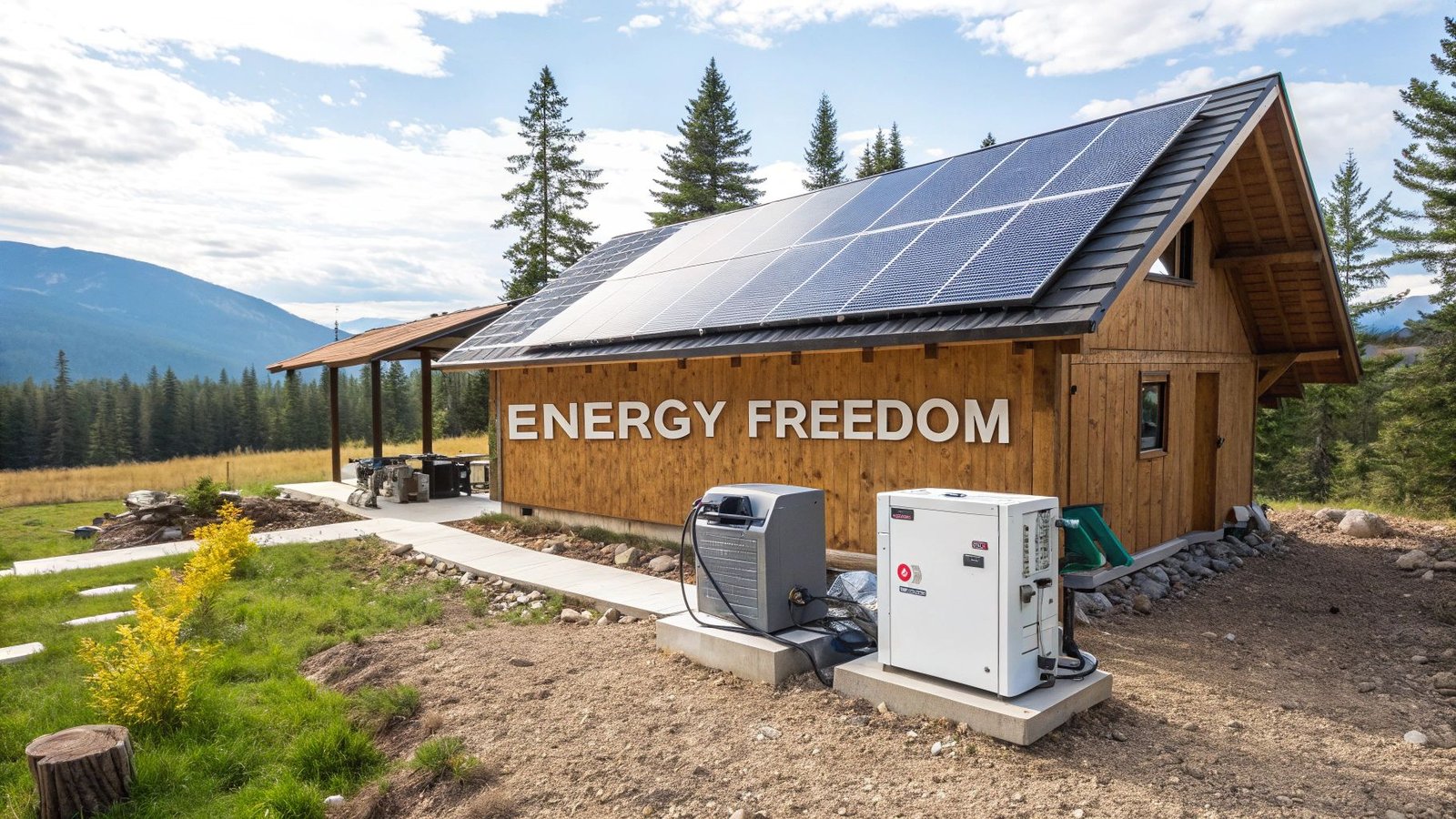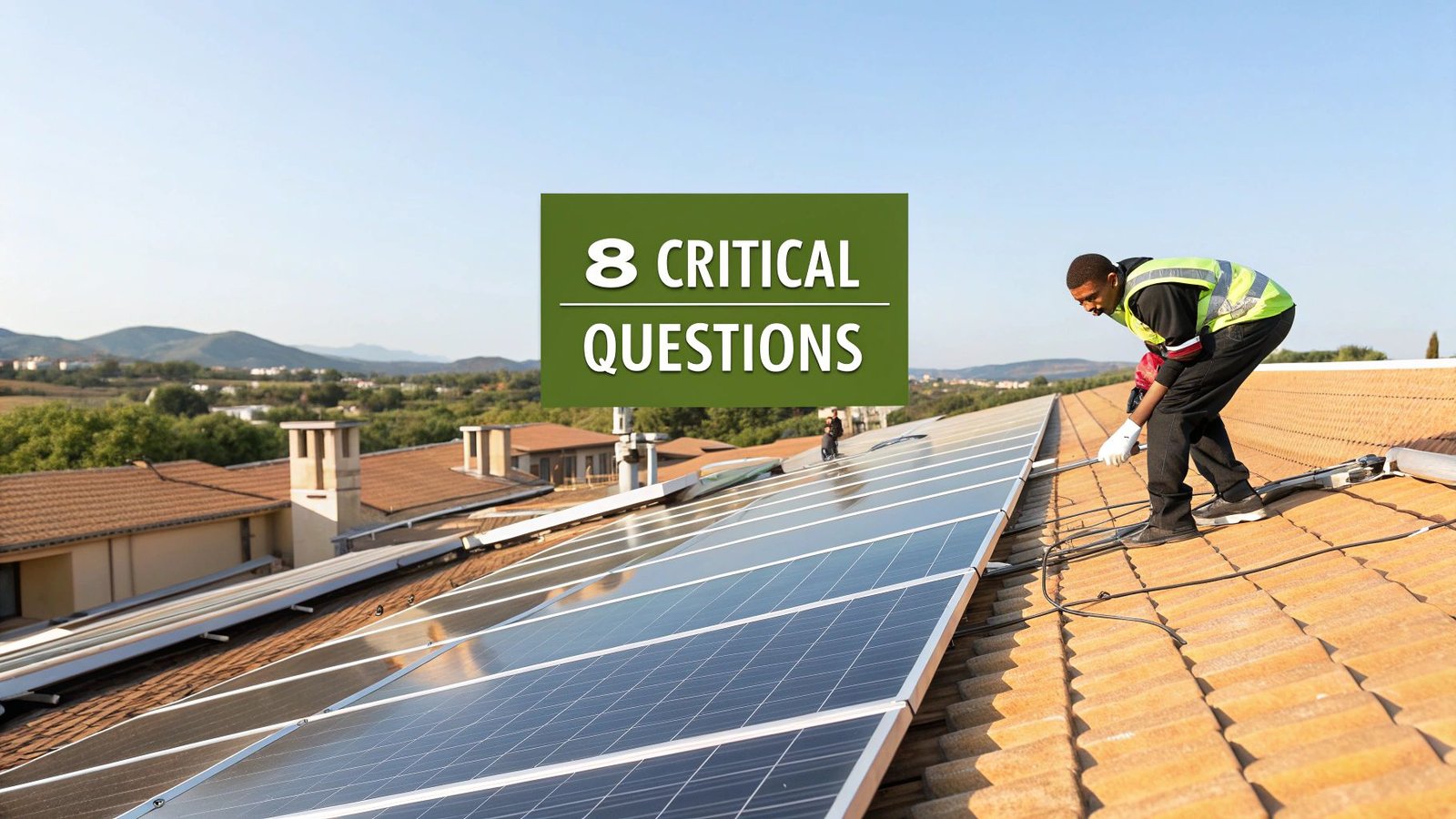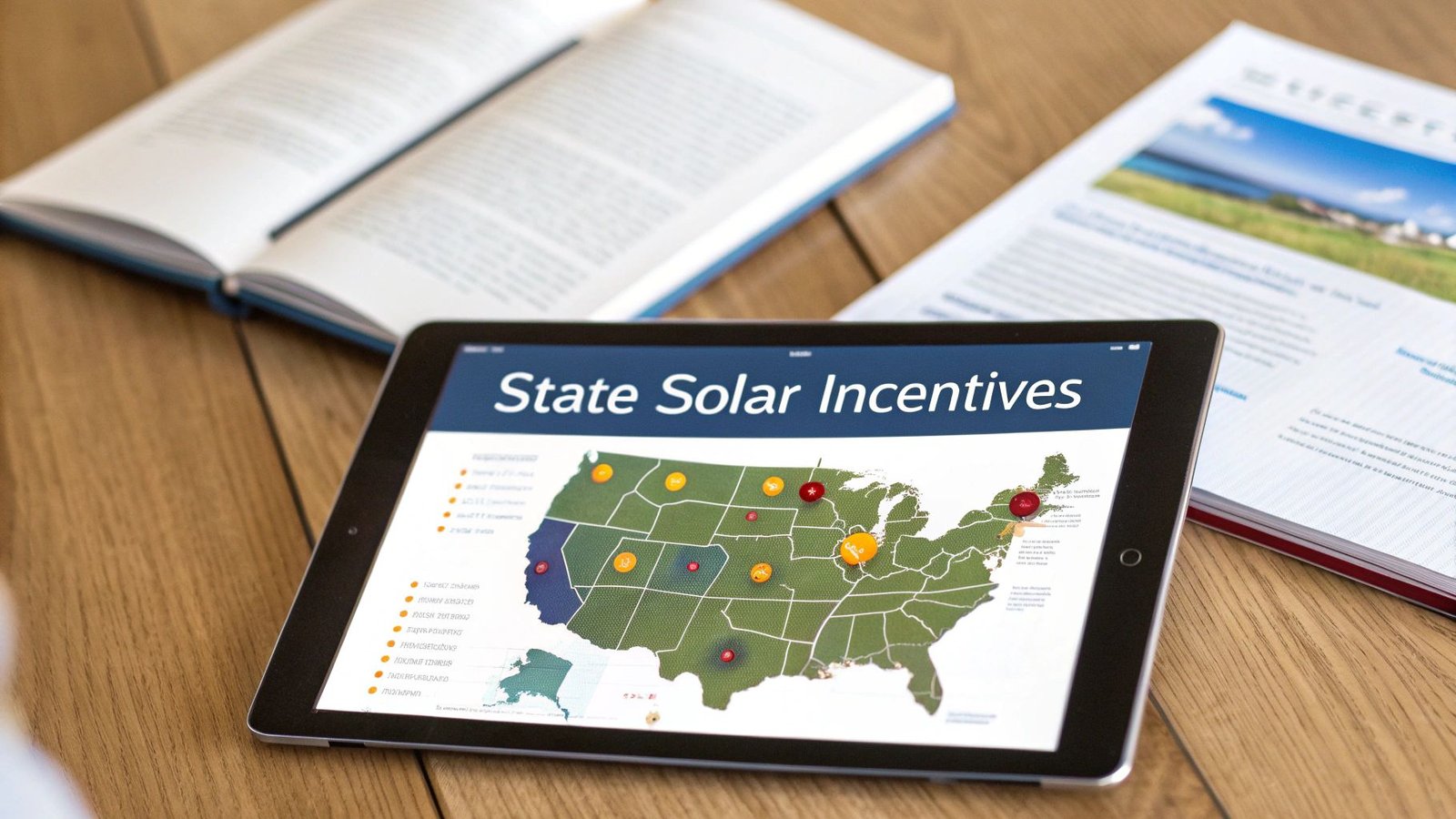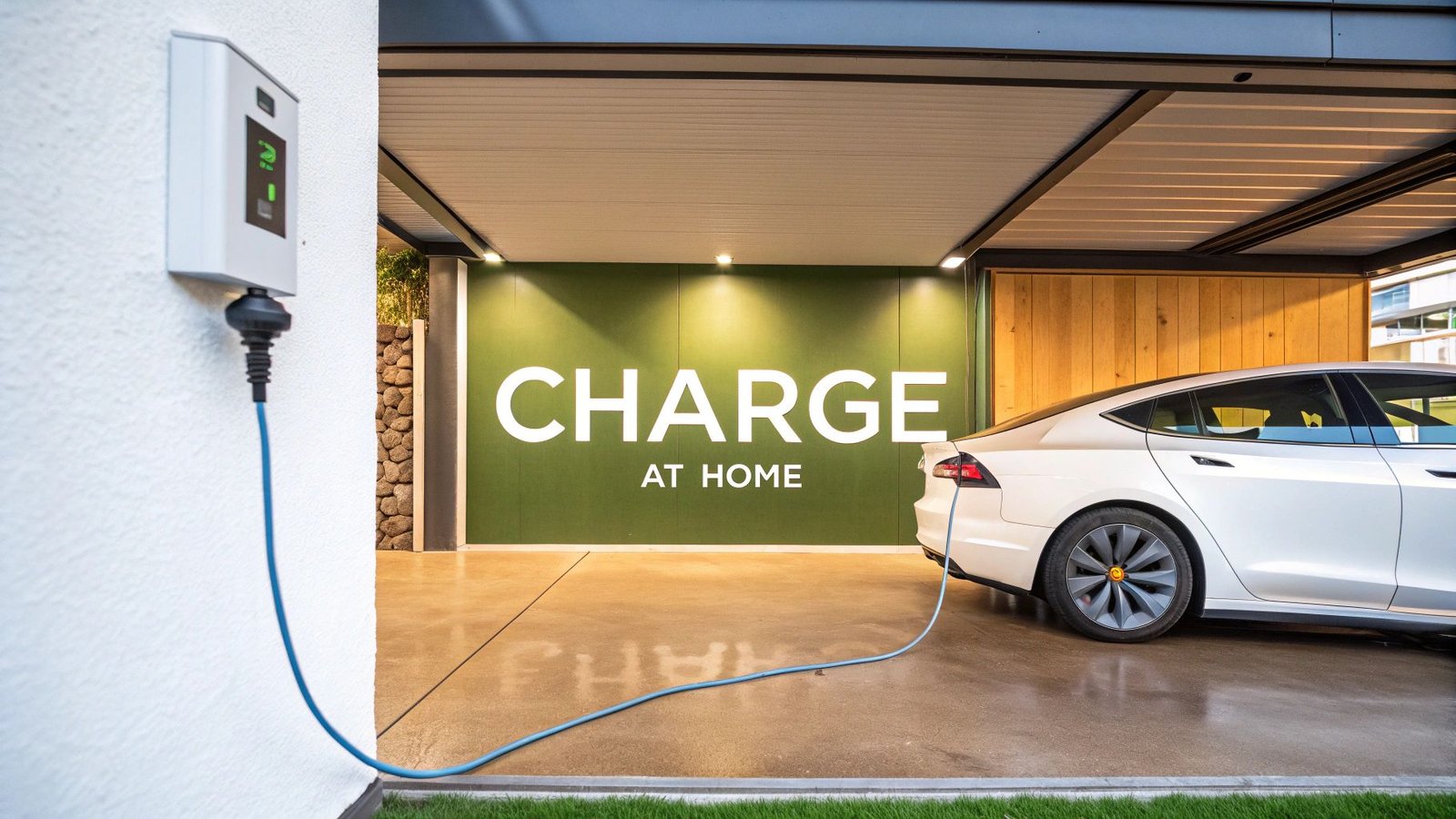Imagine being completely in charge of your own power. No more utility bills, no more worries about grid failures—just reliable, self-generated energy. That's the freedom you get with off grid solar power solutions. These aren't just solar panels; they're your own personal, self-sustaining power plant.
Your First Step Towards Energy Independence
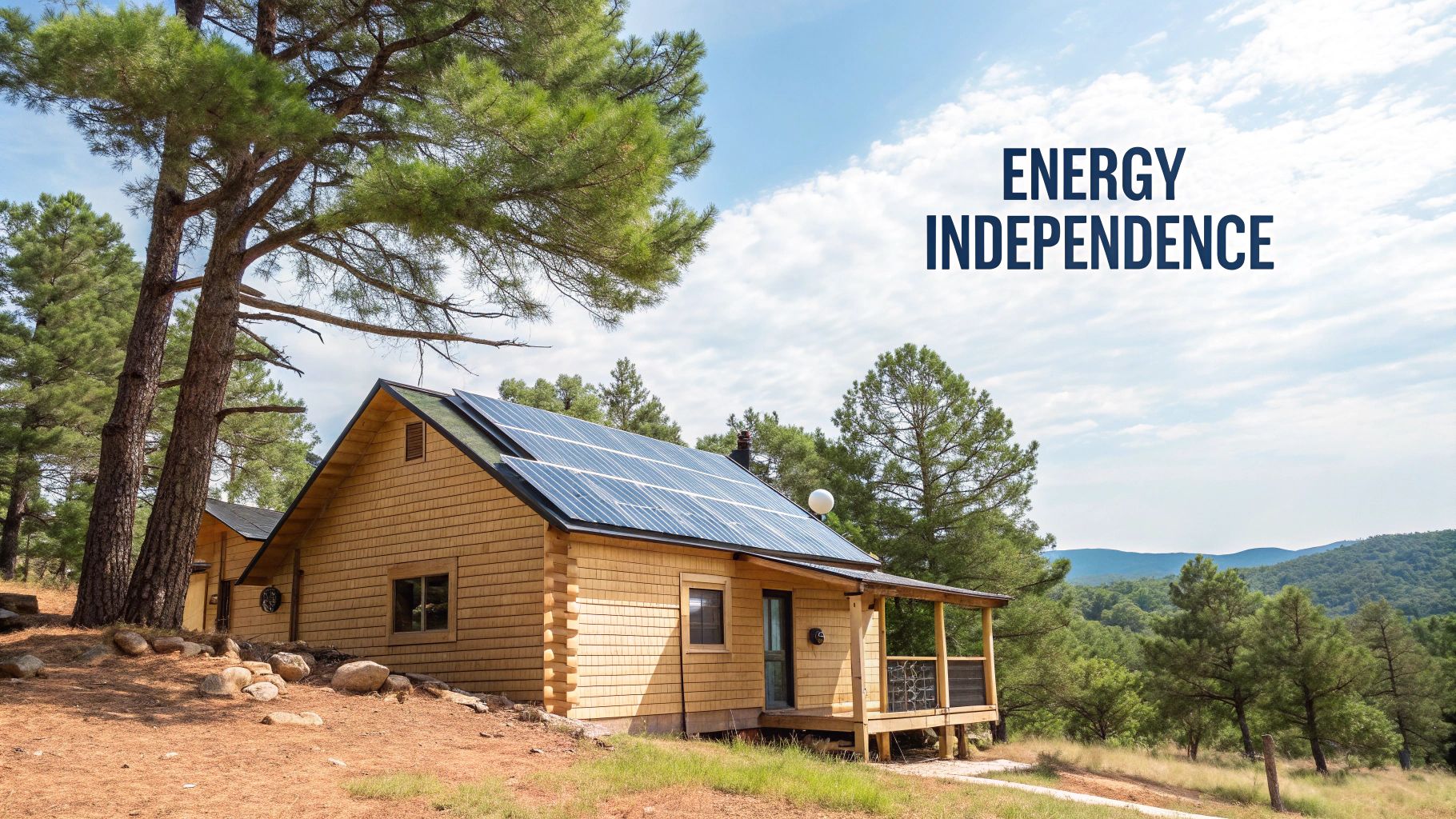
Going off-grid means true energy independence. Unlike a grid-tied system that leans on the utility company for backup, an off-grid setup stands entirely on its own. This makes it a perfect fit for remote cabins, full-time homes in areas with spotty power, or anyone who simply wants total control over their energy.
The idea is straightforward but incredibly effective. Your system collects sunlight, stores that energy for later, and then delivers it as usable power whenever you need it. You call the shots, protecting yourself from unpredictable rate hikes and blackouts.
The Core of an Off-Grid System
At its heart, an off-grid system is like a tiny, self-contained utility. Three key pieces of equipment work together seamlessly, creating a personal energy production line that starts with the sun and ends at your light switch.
Each component has a critical job to do.
- Solar Panels: These are the workhorses. They catch sunlight and turn it into direct current (DC) electricity, kicking off the whole process.
- Battery Bank: Think of this as your energy savings account. It stores all the extra power your panels generate during the day, making sure you have electricity at night or on cloudy days.
- Power Inverter: This is the system's translator. It takes the DC power stored in your batteries and converts it into the alternating current (AC) power that nearly all of your home appliances run on.
Getting these three components to work in harmony is the key to designing great off grid solar power solutions. While it takes some careful planning upfront, the long-term rewards are huge.
In fact, the demand is growing fast. Sales of off-grid solar systems jumped by 17% in the first half of 2024, proving just how many people are looking for energy security. To see how these systems are put into practice, take a look at our guide on solar power solutions for your home. It breaks down the entire process and shows you how to achieve your own energy independence.
Decoding Your Off-Grid Solar Power System
To really get a feel for how an off-grid solar system works, let’s think of it like managing your own personal water supply. It’s a simple analogy, but it perfectly breaks down how each part works together to give you a steady, reliable flow of power whenever you need it.
Your solar panels are the 'rain collectors.' Their only job is to sit there and soak up the sun, converting that sunlight into direct current (DC) electricity. This is the raw energy that kicks off your entire independent power supply.
Next, that DC power travels to the charge controller. This little device is the 'smart valve' of your whole setup. It’s crucial because it carefully manages how much energy goes into your batteries, protecting them from overcharging and damage. Think of it as the gatekeeper for your energy reservoir.
The battery bank is your 'water tank.' This is where all the energy you collect during sunny days gets stored, ready for you to use at night or on those grey, overcast days when the sun isn't shining.
Finally, the power inverter acts as your 'faucet and purifier.' It takes the stored DC electricity from the batteries and converts it into the alternating current (AC) power your home actually uses. This is the juice that runs everything from your lights and refrigerator to your laptop.
A Closer Look at the Key Components
Knowing the basic roles is a great start, but the real power comes from understanding your options for each component. The specific hardware you choose will make or break your system, and the best choice always comes down to your unique energy needs and budget.
This quick reference table breaks down the essential components, their jobs, and why choosing the right one matters.
Essential Off-Grid Solar Component Roles
| Component | Primary Role | Key Options | Impact on System |
|---|---|---|---|
| Solar Panels | Captures sunlight and converts it to DC electricity. | Monocrystalline, Polycrystalline | Determines total energy generation potential and space efficiency. |
| Charge Controller | Regulates power from panels to batteries to prevent overcharging. | PWM (Pulse Width Modulation), MPPT (Maximum Power Point Tracking) | Affects charging efficiency and battery lifespan. MPPT is significantly more efficient. |
| Battery Bank | Stores DC energy for later use (e.g., at night, on cloudy days). | Lead-Acid (Flooded, AGM), Lithium-Ion (LiFePO4) | Defines your energy storage capacity and how long you can go without sun. |
| Power Inverter | Converts stored DC power from batteries into usable AC power for appliances. | Modified Sine Wave, Pure Sine Wave | Determines the quality of your power. Pure Sine Wave is essential for modern electronics. |
As you can see, each piece is a critical link in the chain. A misstep on one component can bottleneck the entire system's performance.
This infographic gives you a great visual of how these parts come together in a real-world setup.
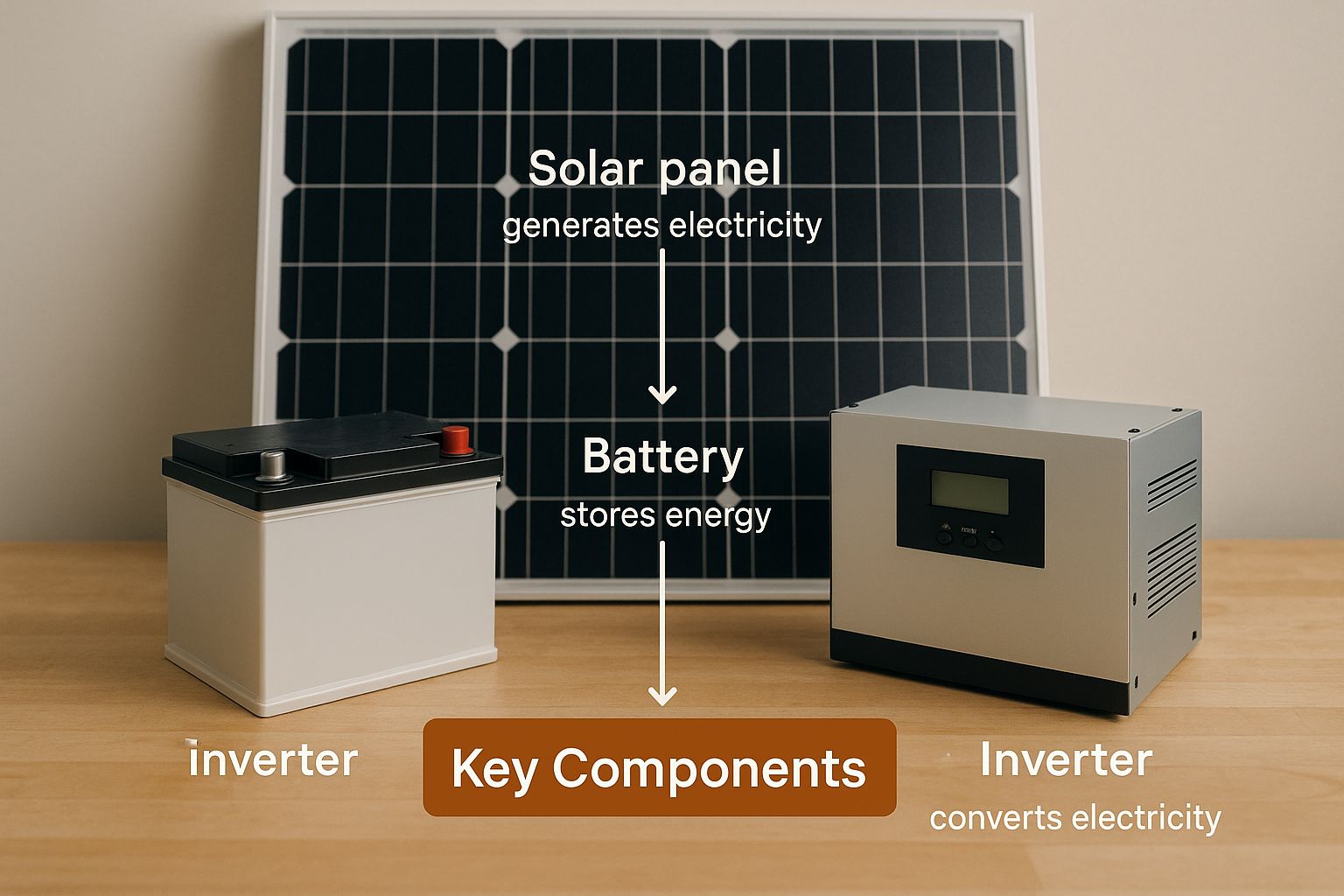
Seeing the solar panel, battery, and inverter laid out like this really helps connect the dots from sunlight hitting a panel to you being able to switch on a light inside.
Let's dive a little deeper into the two electronic "brains" of the operation: the charge controller and the inverter.
-
Charge Controllers: You'll run into two main types here. PWM (Pulse Width Modulation) controllers are the simpler, less expensive option, and they can work just fine for small, basic systems. But MPPT (Maximum Power Point Tracking) controllers are the clear winner for performance, boosting your power harvest by up to 30%, especially when it's cold or partly cloudy.
-
Inverters: This choice is even more critical. A Modified Sine Wave inverter is the cheap and cheerful option, but its "choppy" power output can wreak havoc on sensitive electronics. Modern TVs, computers, and medical devices just weren't built for it. A Pure Sine Wave inverter, however, produces clean, stable AC power that’s often better than what you’d get from the grid, keeping all your appliances happy and safe.
For any serious off-grid home or cabin, a Pure Sine Wave inverter isn't just a recommendation—it's a necessity. The risk of frying a thousand-dollar laptop to save a couple hundred bucks on the inverter is a gamble that never pays off.
Understanding the System as a Whole
It's all about synergy. The best panels in the world are useless if you don't have a battery bank to store the power they produce. Likewise, a massive battery bank is just a heavy box without an inverter to turn its stored energy into something your home can use. Every component depends on the others.
This interconnectedness is why so many people are drawn to energy independence. It's a fast-growing market, too. The global off-grid solar PV panel market is expected to jump from $3.11 billion in 2024 to a whopping $10.11 billion by 2035. This boom is happening because the technology is getting cheaper and the need for reliable power off the beaten path is only increasing. You can dig into the numbers and find out more about the off-grid solar market outlook on SphericalInsights.com.
How to Correctly Size Your Solar System
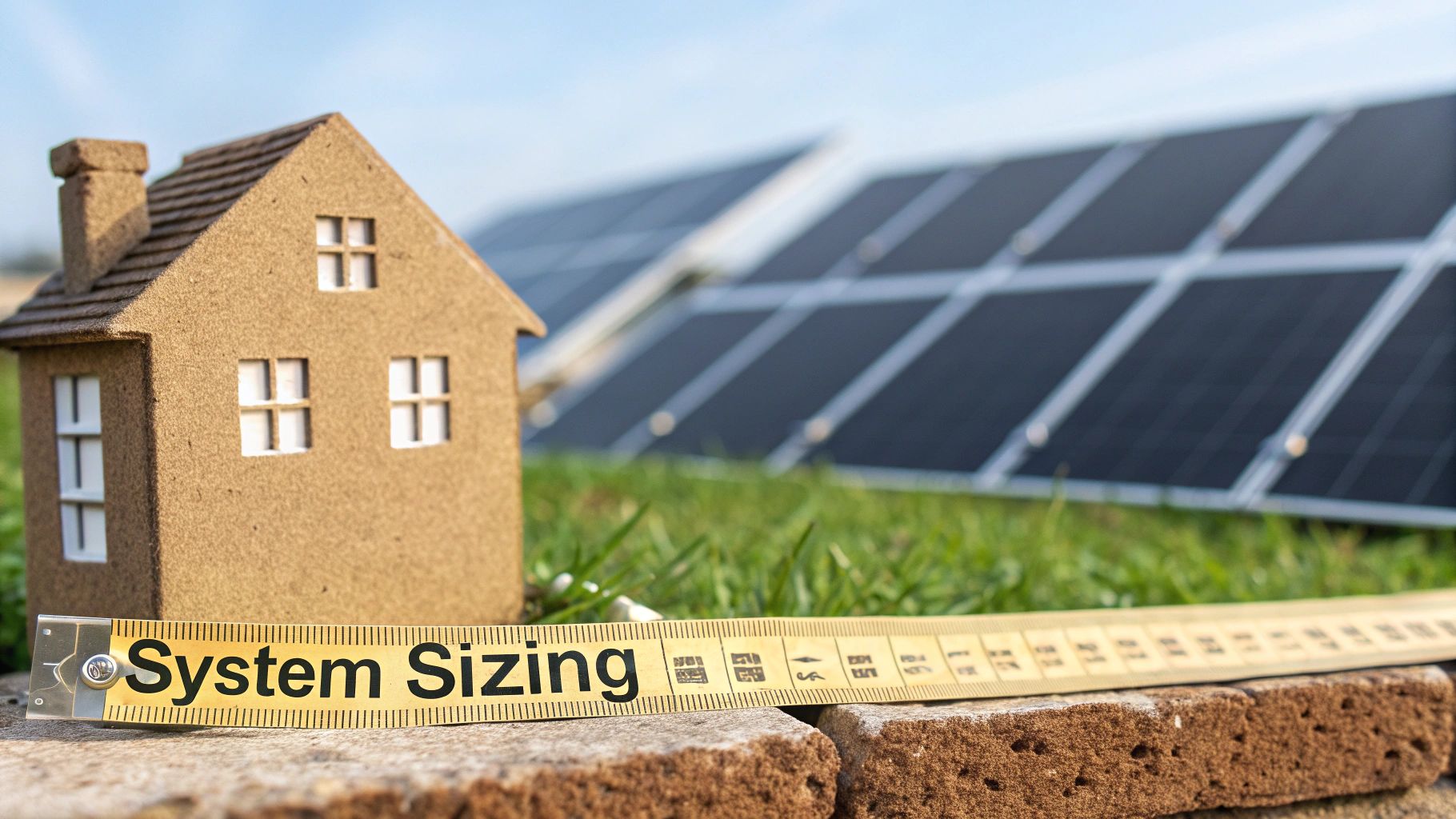
Getting the size of your system right is, without a doubt, the most critical part of going off-grid. Get this wrong, and you're in for a world of frustration. It’s a lot like creating a detailed "energy budget" for your lifestyle.
If you build it too small, you'll be dealing with constant power shortages. Too big, and you've just wasted a pile of money on equipment you’ll never actually use. The goal here is to design a personal power plant that perfectly matches your real-world needs.
Let’s walk through the three key calculations you'll need to nail down: how much energy you use daily, how much battery storage you need, and how big your solar array should be.
Step 1: Create Your Energy Audit
Before you even think about buying a single panel, you need to know exactly how much power you consume. This starts with a simple but thorough energy audit—basically, an inventory of every single appliance and device you plan to run.
For each item on your list, you'll need two bits of information:
- Wattage: How much power it draws when it's on. You can usually find this on a little sticker or tag on the back of the appliance.
- Daily Runtime: Be honest with yourself here. How many hours a day will you really use it?
With those two numbers, you can figure out the daily energy demand in watt-hours (Wh). The formula is simple:
Appliance Wattage (W) x Daily Runtime (Hours) = Daily Watt-Hours (Wh)
For example, a 100-watt TV running for 4 hours a day uses 400 Wh. You have to do this for everything, right down to your phone charger. Before you can choose any hardware, mastering electrical load calculation is the foundational skill for designing an off-grid system that won't let you down.
Step 2: Determine Your Battery Bank Size
Once you have your total daily watt-hours tallied up, it's time to figure out your battery bank. This isn't just about storing enough power for one day; it's about building a buffer for when the sun doesn't shine. This buffer is what we call days of autonomy.
Days of autonomy is the number of cloudy, sunless days your system can keep you powered up. For most off-grid homes, aiming for 2 to 4 days is a solid, reliable target. This is your insurance policy against a long stretch of stormy weather.
You'll use your total daily watt-hours and your chosen days of autonomy to calculate your required battery capacity. If you want to see this in action with more detailed examples, check out our complete guide on how to size a solar system.
Step 3: Calculate Your Solar Array Size
Finally, we get to the panels. You need to figure out how large of a solar array you'll need to not only run your home during the day but also fully recharge your batteries. This calculation is heavily influenced by where you live, specifically your area's average peak sun hours.
Now, peak sun hours aren't the same as hours of daylight. It's a standardized measure of solar intensity. One peak sun hour is equivalent to 1,000 watts of sunlight hitting a square meter for one hour. This number varies dramatically by location. Someone in the sunny Southwest might get 5-6 peak sun hours, while a spot in the Northeast might only see 3-4 on average.
This difference has a huge impact on your system design, as you can see below.
Average Daily Peak Sun Hours by U.S. Region
| Region | Average Peak Sun Hours (Daily) | Impact on System Sizing |
|---|---|---|
| Southwest | 5.5 – 7.0 Hours | Smaller solar array needed to meet energy goals. |
| Southeast | 4.5 – 5.5 Hours | Moderate solar array size required. |
| Midwest | 4.0 – 5.0 Hours | Larger solar array needed compared to southern regions. |
| Northeast | 3.5 – 4.5 Hours | Requires a significantly larger array for the same energy output. |
By meticulously calculating your needs, planning for cloudy days, and factoring in your local sun hours, you can build an off-grid system that delivers reliable, independent power all year long.
Choosing the Best Battery for Your Energy Bank
Your battery bank is the heart of your off-grid solar power system. It’s the reservoir that keeps your lights on and your home running long after the sun has set. Picking the right battery isn't just a technical detail—it fundamentally defines the reliability, longevity, and even the long-term cost of your energy independence.
This decision usually boils down to two main contenders: the old-school, tried-and-true Lead-Acid batteries and the more modern Lithium-ion batteries, specifically the incredibly stable Lithium Iron Phosphate (LiFePO4) variety. Think of it like choosing between a dependable, classic work truck (Lead-Acid) and a sleek, high-performance electric vehicle (Lithium).
Both will get the job done, but how they perform, how long they last, and their overall value are worlds apart. Let's break down the differences on the metrics that really matter for off-grid living so you can make a smart, informed investment.
Lifespan and Usable Capacity
The single biggest difference between these two battery types is how long they last and how much of their stored power you can actually use. These two factors are deeply connected and have a massive impact on your system's day-to-day performance.
First, let's talk about cycle life. This is simply the number of times you can charge and discharge a battery before its ability to hold a charge starts to fade. A typical lead-acid battery might give you 500 to 1,500 cycles. A LiFePO4 battery, on the other hand, can easily deliver 3,000 to 7,000 cycles—and sometimes even more. That means a lithium battery can last several times longer under the exact same conditions.
Next up is the Depth of Discharge (DoD). This is just a fancy way of saying how much of the battery's total capacity you can safely use before you risk damaging it. With lead-acid batteries, the rule of thumb is to never go below 50% if you want to get the most life out of them. But LiFePO4 batteries? You can safely drain them down to 80-95% without a second thought.
What does this mean in the real world? A 100Ah lithium battery gives you nearly double the usable energy of a 100Ah lead-acid battery. You'd have to buy a much larger, heavier, and bulkier lead-acid bank to get the same amount of power.
When you're dealing with high-performance batteries, safety should always be top of mind. While LiFePO4 is one of the safest chemistries out there, it’s always a good idea to be informed. It's well worth your time understanding the risks of Li-ion battery explosions and how to ensure safety.
The Real Cost Over a Lifetime
Lead-acid batteries might look like the cheaper option at first glance, but their shorter lifespan and limited usable capacity often make them the more expensive choice in the long run. To really understand the value, you have to look at the Total Cost of Ownership (TCO).
The chart below lays it all out, comparing the lifetime cost-per-kilowatt-hour for both technologies. It takes everything into account: the initial purchase price, how many cycles you'll get, and how much energy you can actually use.
Lifetime Cost Comparison: Lead-Acid vs. LiFePO4
| Metric | Flooded Lead-Acid | Lithium Iron Phosphate (LiFePO4) |
|---|---|---|
| Upfront Cost | Low (~$150 per kWh) | High (~$400 per kWh) |
| Typical Cycle Life | 1,000 cycles @ 50% DoD | 5,000 cycles @ 80% DoD |
| Usable Energy | 50% of rated capacity | ~90% of rated capacity |
| Lifetime Energy Output | Lower | Significantly Higher |
| Estimated Lifetime Cost | ~$0.30 per kWh | ~$0.09 per kWh |
As you can see, even with the higher upfront cost, the price you pay to store and use each kilowatt-hour of energy over the battery's life is drastically lower with LiFePO4. Why? Because you won't be replacing them every few years. For a deeper dive into storage technologies, check out our complete guide on how to store solar energy.
The initial investment for a complete off-grid setup can be a hurdle, no doubt. But the freedom of energy autonomy and the long-term savings make off grid solar power solutions an unbeatable choice, especially for remote locations. And with ongoing innovations in battery storage, these systems are only getting more efficient and valuable.
Getting It Installed and Keeping It Running
You’ve designed the perfect off-grid solar system. That's a huge step, but the real work starts now. Getting your system installed correctly and keeping it maintained is what separates a reliable power source from an expensive headache. Think of it like a classic car—it's not enough to have all the right parts; you need a precise assembly and regular tune-ups to keep it humming for years.
The installation itself is full of little details that have a big impact. One of the most critical is getting your panel orientation just right. For those of us in the Northern Hemisphere, that means pointing your panels true south and tilting them at an angle close to your latitude. It sounds small, but getting this right can squeeze a surprising amount of extra power out of every single day.
Another thing you absolutely can't skimp on is using the correct wire gauge. Using wires that are too thin is like forcing water through a pinhole. You’ll lose precious energy to heat, create a potential fire risk, and choke your system's performance.
DIY vs. Hiring a Pro
This is the big question every off-grid hopeful faces: "Can I install this myself?" Going the DIY route can definitely save you some cash on labor, but it's not a decision to take lightly. You’re dealing with high-voltage electricity and hoisting heavy gear. One wrong move could fry expensive equipment or, worse, put you in serious danger.
Hiring a certified professional brings peace of mind. They live and breathe this stuff. They'll make sure everything is installed safely, meets any local codes, and is dialed in for the best possible performance. For a full-home off grid solar power solution, the cost of a pro is almost always a worthwhile investment.
Expert Insight: A good installer sees things you might not. They'll notice the small tree that will cast a shadow in five years or the section of your roof that gets less sun in the winter. That kind of foresight saves you from performance dips you'd otherwise be scratching your head about later.
The good news is that finding a qualified expert is easier than ever. Solar is booming. By the end of 2024, the total installed capacity of solar PV systems worldwide flew past 2.2 terawatts (TW). This massive growth means more experienced installers and lower component costs for everyone. You can dive deeper into these trends and discover insights on the global PV market on IEA-PVPS.org.
Your Simple Maintenance Checklist
Once your system is up and running, a little bit of regular attention will keep it in peak condition. It's not complicated, but it is crucial.
Here’s a simple checklist to follow:
- Clean Your Panels (Quarterly): A layer of dust, pollen, or bird droppings can cut your panel's output by 5% to 15%. A quick wash with a soft brush and some water is all it takes to bring them back to full power.
- Check Battery Connections (Every 6 Months): Pop the hood on your battery bank. Make sure all terminals are tight and clean—no corrosion. If you have flooded lead-acid batteries, now is the time to top them off with distilled water.
- Keep an Eye on Your Monitor (Weekly): Get in the habit of glancing at your system monitor. If you see a sudden, unexplained drop in power production, it’s an early warning that something might be wrong with a panel or a connection.
- Do a Walk-Around (Annually): At least once a year, give the whole system a visual inspection. Look for cracked panels, check that wires aren't being chewed on by critters, and make sure all the mounting hardware is still tight and secure.
Answering Your Off-Grid Solar Questions
Deciding to go off-grid is a huge step toward energy independence, so it's only natural to have a lot of questions. Let's walk through some of the most common things people ask, so you can feel confident moving forward with your own off-grid solar power solution.
What’s the Real Cost of a Complete System?
This is usually the first question on everyone's mind, and the honest answer is: it depends almost entirely on how much power you use. A simple setup for a small cabin might only cost a few thousand dollars. But for a full-time home with modern appliances, you're realistically looking at a range of $20,000 to $50,000+.
The two biggest line items driving that price are the number of solar panels you need and, most importantly, the size of your battery bank. High-quality lithium batteries, which are the best choice for long-term performance, make up a huge chunk of that initial investment. It feels like a lot upfront, but you have to think of it as prepaying for decades of electricity bills that you'll never see again.
To give you a better idea of where the money goes, here’s a rough breakdown for a typical residential off-grid system.
Estimated Cost Breakdown for a Residential Off-Grid System
pie
title Cost Breakdown of a Typical Off-Grid System
"Battery Bank (LiFePO4)" : 40
"Solar Panels & Racking" : 25
"Inverter & Charge Controller" : 15
"Installation Labor & Permitting" : 15
"Wiring, Fuses & Misc." : 5
As you can see, the battery bank is the heart of the budget. That’s why getting the storage technology right from the very beginning is so critical.
How Does an Off-Grid System Handle Bad Weather?
This is exactly what your battery bank is for. On a bright, sunny day, your panels will often generate way more power than you’re using. All that extra energy gets stored in your batteries, filling them up for when you need them.
When night falls or a few cloudy days roll in, your system automatically starts drawing power from that stored energy. A well-designed system is built with a certain number of "days of autonomy"—usually two to four days—which means you have enough juice to ride out those low-sun periods without a flicker. For extra peace of mind, especially in places with long winters, many people also connect a small backup generator that can top off the batteries if a storm lasts longer than expected.
Should I Attempt a DIY Solar Installation?
It’s tempting, I get it. But unless you have a deep background in electrical work and construction, this is one area where I’d strongly advise against it. You're working with high-voltage DC electricity, which is no joke if you don't know exactly what you're doing. There’s also heavy equipment, complicated wiring, and a lot of precise settings that need to be perfect.
One small mistake can lead to a system that underperforms, fries expensive equipment, or worse, creates a serious safety hazard like an electrical fire.
For the vast majority of homeowners, hiring a certified solar installer is the smartest move. They have the right tools, the training, and the experience to make sure your system is installed safely, meets any local codes, and is dialed in to produce every last watt of power it can.
What Is the Lifespan of Off-Grid Solar Components?
Good-quality off-grid gear is built to last. With a little care, your system should be a reliable power source for decades. Of course, different parts have different lifespans.
Here’s a look at what you can generally expect from the core components:
gantt
title Expected Lifespan of Off-Grid Components
dateFormat YYYY
axisFormat %Y
section Solar Panels
Performance Warranty :p1, 2024, 25y
Expected Operation :eo1, after p1, 5y
section Inverter & Controller
Typical Lifespan :ic1, 2024, 15y
section Batteries
Flooded Lead-Acid :fla, 2024, 8y
LiFePO4 Lithium :lfp, 2024, 20y
* **Solar Panels:** These things are tanks. Most top-tier panels have a **25-year performance warranty** and will likely keep chugging along, producing power, for 30 years or more.
* **Inverters & Charge Controllers:** Think of these as the electronic brains of the operation. They typically have a lifespan of about **10 to 15 years** before they might need to be replaced.
* **Batteries:** This is where you see the biggest difference. Old-school flooded lead-acid batteries might only last **5 to 8 years** and require a lot of maintenance. Modern LiFePO4 lithium batteries, on the other hand, are a true long-term investment, often lasting **15 years or longer**. They easily deliver the best value over the life of the system.
Keeping up with the regular maintenance we talked about earlier is the key to hitting—and even exceeding—these numbers.
Ready to take control of your energy future? At Radiant Energy, we specialize in designing and installing robust off-grid solar power solutions that deliver true independence. Contact us today to start planning your custom system.
Find your path to energy freedom at https://radiantenergysolar.com.

